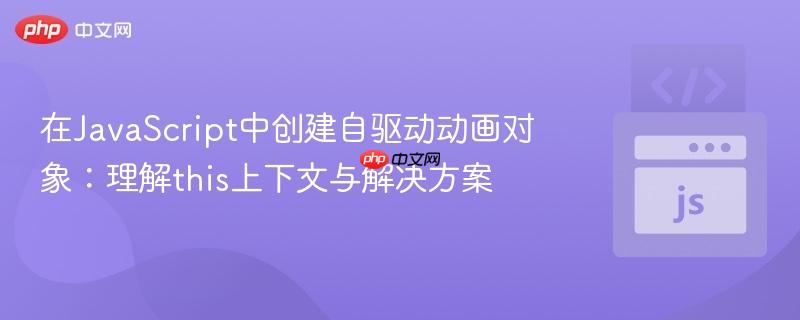
本文深入探讨了在javascript中创建可自驱动动画对象的常见挑战,特别是当使用`settimeout`或`setinterval`时`this`上下文丢失的问题。文章详细解释了`this`指向`window`对象的原因,并提供了两种有效的解决方案:利用es6箭头函数的词法作用域`this`绑定,以及使用`function.prototype.bind()`方法显式绑定`this`。通过示例代码,读者将学会如何构建结构清晰、性能优化的自驱动动画组件。
在JavaScript中,我们经常需要创建能够独立执行行为的对象,尤其是在图形和动画场景中。例如,一个“盒子”对象可能需要自己管理其位置并在画布上移动。然而,在实现这类自驱动动画时,一个常见的陷阱是this上下文的丢失,这会导致对象的方法无法正确访问其自身的属性。本教程将详细解析这一问题,并提供两种健壮的解决方案。
考虑以下场景,我们尝试创建一个SelfMovingBox对象,它包含一个animate方法,该方法通过setTimeout递归调用自身以实现动画效果。
const Canvas = document.getElementById("diagramCanvas");
const CanvasContext = Canvas.getContext('2d');
const width = Canvas.width, height = Canvas.height;
function SelfMovingBox() {
this.x = width; // 初始位置
this.y = 10;
this.width = 100;
this.height = 20;
this.speed = 10;
this.animate = function() {
// 在第一次调用时,this指向SelfMovingBox实例
// 但在setTimeout回调中,this会指向全局对象(Window)
CanvasContext.clearRect(this.x, this.y, this.width, this.height); // 清除旧位置
this.x -= this.speed; // 更新位置
// 检查是否超出边界,如果超出则停止或重置
if (this.x + this.width < 0) {
console.log("Box out of bounds, stopping animation.");
return; // 停止动画
}
CanvasContext.save();
CanvasContext.strokeStyle = 'blue';
CanvasContext.strokeRect(this.x, this.y, this.width, this.height); // 绘制新位置
CanvasContext.restore();
// 关键问题所在:setTimeout的回调函数中,this的指向会改变
setTimeout(this.animate, 100);
};
}
// 假设HTML中有一个<canvas id="diagramCanvas"></canvas>元素
// let box = new SelfMovingBox();
// box.animate(); // 首次调用时正常,但setTimeout中的this会出错当box.animate()首次被调用时,this确实指向SelfMovingBox的实例,因此this.x等属性可以被正确访问。然而,当setTimeout(this.animate, 100)被执行时,this.animate方法被作为回调函数传递给了setTimeout。在非严格模式下,当一个函数作为普通函数调用(而不是作为对象的方法调用,也不是通过new调用)时,其内部的this会默认指向全局对象(在浏览器环境中是Window对象)。
这意味着,在setTimeout内部再次执行this.animate时,this.x、this.y等实际上是在尝试访问Window.x、Window.y,这些属性通常是不存在的或不相关的,导致动画无法继续或行为异常,且不会抛出显式错误。
立即学习“Java免费学习笔记(深入)”;
ES6引入的箭头函数提供了一种更简洁的方式来处理this上下文。箭头函数没有自己的this绑定,它们会捕获其所在上下文的this值。这意味着,在定义animate方法时使用箭头函数,this将始终指向SelfMovingBox实例。
function SelfMovingBoxArrow() {
this.x = width;
this.y = 10;
this.width = 100;
this.height = 20;
this.speed = 10;
// 使用箭头函数定义animate方法
this.animate = () => {
CanvasContext.clearRect(this.x, this.y, this.width, this.height);
this.x -= this.speed;
if (this.x + this.width < 0) {
console.log("Box out of bounds, stopping animation.");
return;
}
CanvasContext.save();
CanvasContext.strokeStyle = 'blue';
CanvasContext.strokeRect(this.x, this.y, this.width, this.height);
CanvasContext.restore();
// 这里的this仍然指向SelfMovingBox实例
setTimeout(this.animate, 100);
};
}
// let boxArrow = new SelfMovingBoxArrow();
// boxArrow.animate(); // 现在动画将正常循环通过将this.animate定义为一个箭头函数,它会“记住”其创建时所处的SelfMovingBox实例的this。无论animate方法在何处被调用,其内部的this都将保持不变,从而正确访问对象的属性。
bind()方法是JavaScript中用于显式绑定函数this上下文的另一个强大工具。它会创建一个新的函数,当这个新函数被调用时,其this关键字会被设置为提供的值。
function SelfMovingBoxBind() {
this.x = width;
this.y = 10;
this.width = 100;
this.height = 20;
this.speed = 10;
// 定义animate方法,并立即绑定this
this.animate = (function() {
CanvasContext.clearRect(this.x, this.y, this.width, this.height);
this.x -= this.speed;
if (this.x + this.width < 0) {
console.log("Box out of bounds, stopping animation.");
return;
}
CanvasContext.save();
CanvasContext.strokeStyle = 'blue';
CanvasContext.strokeRect(this.x, this.y, this.width, this.height);
CanvasContext.restore();
// 这里的this仍然指向SelfMovingBox实例
setTimeout(this.animate, 100);
}).bind(this); // 在定义时就将animate方法的this绑定到当前的SelfMovingBox实例
}
// let boxBind = new SelfMovingBoxBind();
// boxBind.animate(); // 动画也将正常循环在这个例子中,this.animate = (function() { ... }).bind(this);这行代码在SelfMovingBoxBind构造函数内部,将匿名函数中的this永久地绑定到当前SelfMovingBoxBind实例的this。这样,即使setTimeout以普通函数调用的方式执行this.animate,其内部的this也已经被强制指向了正确的实例。
为了提供一个完整的、可运行的示例,并结合一些动画的最佳实践,我们将使用箭头函数方案并引入requestAnimationFrame以获得更平滑的动画效果。requestAnimationFrame是浏览器专门为动画优化的API,它会在浏览器准备好绘制下一帧时调用回调函数,从而避免掉帧和性能问题。
<!DOCTYPE html>
<html lang="en">
<head>
<meta charset="UTF-8">
<meta name="viewport" content="width=device-width, initial-scale=1.0">
<title>JavaScript 自驱动动画对象</title>
<style>
body { margin: 0; overflow: hidden; display: flex; justify-content: center; align-items: center; min-height: 100vh; background-color: #f0f0f0; }
canvas { border: 1px solid #ccc; background-color: #fff; }
</style>
</head>
<body>
<canvas id="diagramCanvas" width="800" height="300"></canvas>
<script>
const Canvas = document.getElementById("diagramCanvas");
const CanvasContext = Canvas.getContext('2d');
const width = Canvas.width;
const height = Canvas.height;
class SelfMovingBox {
constructor(startX, startY, boxWidth, boxHeight, speed, color = 'blue') {
this.x = startX;
this.y = startY;
this.width = boxWidth;
this.height = boxHeight;
this.speed = speed;
this.color = color;
this.animationFrameId = null; // 用于存储requestAnimationFrame的ID
}
draw() {
CanvasContext.save();
CanvasContext.strokeStyle = this.color;
CanvasContext.strokeRect(this.x, this.y, this.width, this.height);
CanvasContext.restore();
}
// 使用箭头函数确保this上下文正确
update = () => {
// 清除旧位置(只清除自己的区域,更高效)
// 注意:在多物体动画中,通常会清空整个画布再重绘所有物体
// 但对于单个物体,可以尝试局部清除
// 为了简单和通用性,我们这里假设每次都清空整个画布,或者由外部动画循环管理清除
// 如果是多个物体,建议在外部统一管理clearRect(0, 0, width, height);
this.x -= this.speed; // 更新位置
// 如果物体移出左边界,则重置到右边界
if (this.x + this.width < 0) {
this.x = width; // 从右侧重新进入
}
// 请求下一帧动画
this.animationFrameId = requestAnimationFrame(this.update);
}
startAnimation() {
if (!this.animationFrameId) { // 避免重复启动
this.animationFrameId = requestAnimationFrame(this.update);
}
}
stopAnimation() {
if (this.animationFrameId) {
cancelAnimationFrame(this.animationFrameId);
this.animationFrameId = null;
}
}
}
// 动画主循环,负责清空画布和绘制所有活动对象
const animatedObjects = [];
function gameLoop() {
CanvasContext.clearRect(0, 0, width, height); // 清空整个画布
animatedObjects.forEach(obj => {
obj.draw(); // 绘制每个对象
});
// 再次请求下一帧,形成循环
requestAnimationFrame(gameLoop);
}
// 创建并添加动画对象
const box1 = new SelfMovingBox(width, 50, 80, 40, 2, 'red');
const box2 = new SelfMovingBox(width / 2, 150, 60, 30, 1.5, 'green');
const box3 = new SelfMovingBox(width * 0.75, 250, 120, 50, 3, 'purple');
animatedObjects.push(box1, box2, box3);
// 启动每个对象的内部更新逻辑
box1.startAnimation();
box2.startAnimation();
box3.startAnimation();
// 启动主游戏循环(负责清空和绘制)
requestAnimationFrame(gameLoop);
</script>
</body>
</html>注意事项与总结:
通过本文的讲解和示例,您应该能够清晰地理解JavaScript中this上下文在自驱动动画中的作用,并掌握使用箭头函数或bind()方法来解决这一问题的技巧,从而创建出功能完善、性能优化的动画组件。
以上就是在JavaScript中创建自驱动动画对象:理解this上下文与解决方案的详细内容,更多请关注php中文网其它相关文章!

Copyright 2014-2025 https://www.php.cn/ All Rights Reserved | php.cn | 湘ICP备2023035733号